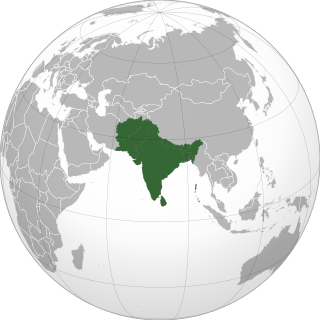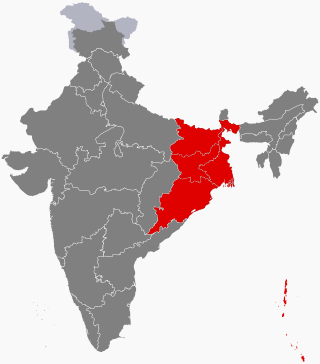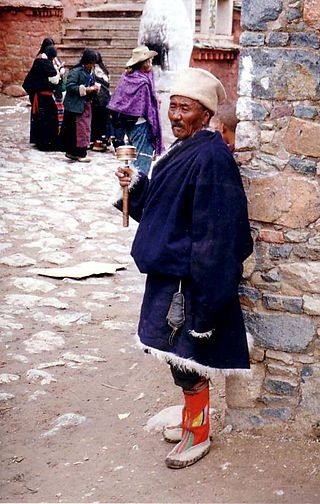Related Research Articles

Bihar is a state in eastern India. It is the third largest state by population, the 12th largest by area, and the 14th largest by GDP in 2021. Bihar borders Uttar Pradesh to its west, Nepal to the north, the northern part of West Bengal to the east, and with Jharkhand to the south. The Bihar plain is split by the river Ganges, which flows from west to east.

Gaya is a city, municipal corporation and the administrative headquarters of Gaya district and Magadh division of the Indian state of Bihar. Gaya is 116 kilometres (72 mi) south of Patna and is the state's second-largest city, with a population of 470,839. The city is surrounded on three sides by small, rocky hills, with the Phalgu River on its eastern side.

The Swadeshi movement was a self-sufficiency movement that was part of the Indian independence movement and contributed to the development of Indian nationalism. Before the BML Government's decision for the partition of Bengal was made public in December 1903, there was a lot of growing discontentment among the Indians. In response the Swadeshi movement was formally started from Town Hall at Calcutta on 7 August 1905 to curb foreign goods by relying on domestic production. Mahatma Gandhi described it as the soul of swaraj (self-rule). The movement took its vast size and shape after rich Indians donated money and land dedicated to Khadi and Gramodyog societies which started cloth production in every household. It also included other village industries so as to make village self-sufficient and self-reliant. The Indian National Congress used this movement as arsenal for its freedom struggle and ultimately on 15 August 1947, a hand-spun Khadi tricolor Ashoka Chakra Indian flag was unfurled at Princess Park near India Gate, New Delhi by Jawaharlal Nehru.

The history of Bihar is one of the most varied in India. Bihar consists of three distinct regions, each has its own distinct history and culture. They are Magadha, Mithila and Bhojpur. Chirand, on the northern bank of the Ganga River, in Saran district, has an archaeological record dating from the Neolithic age. Regions of Bihar—such as Magadha, Mithila and Anga—are mentioned in religious texts and epics of ancient India. Mithila is believed to be the centre of Indian power in the Later Vedic period. Mithila first gained prominence after the establishment of the ancient Videha Kingdom. The kings of the Videha were called Janakas. A daughter of one of the Janaks of Mithila, Sita, is mentioned as consort of Lord Rama in the Hindu epic Ramayana. The kingdom later became incorporated into the Vajjika League which had its capital in the city of Vaishali, which is also in Mithila.

East India is a region of India consisting of the Indian states of Bihar, Jharkhand, Odisha and West Bengal and also the union territory of the Andaman and Nicobar Islands. The region roughly corresponds to the historical region of Magadha from which it inherits its various Eastern Indo-Aryan languages.

Yogendra Shukla was an Indian nationalist and freedom fighter from Bihar. He served in the Cellular Jail, and he was among the founders of Hindustan Socialist Republican Association (HSRA). Along with Basawon Singh (Sinha), he was among the founding members of the Congress Socialist Party from Bihar.

The most important places in Buddhism are located in the Indo-Gangetic Plain of northern India and southern Nepal, in the area between New Delhi and Rajgir. This is the area where Gautama Buddha lived and taught, and the main sites connected to his life are now important places of pilgrimage for both Buddhists and Hindus. Many countries that are or were predominantly Buddhist have shrines and places which can be visited as a pilgrimage.
Bihar has been a major centre of learning and home to one of the oldest universities of India dating back to the fifth century and the tradition of learning which had its origin from ancient times was lost during the medieval period when it is believed that marauding armies of the invaders destroyed these centres of learning.

Bihar (Hindi: Bihar,, [Bihar] in eastern India is one of the oldest inhabited places in the world with a history going back 3000 years. The rich culture and heritage of Bihar is evident from the innumerable ancient monuments that are dotted all over the state. Bihar is home to many tourist attractions and is visited by large numbers of tourists from all over the world. Around total 6 million tourists visit Bihar every year.
Hinduism is the most followed religion in Bihar, followed by nearly 82.7% of total population as per 2011 Census. Islam is the second-most followed religion which is followed by nearly 16.8% of population. There is also a significant population of Jains and Christians in the state.

Harnaut is a city in the Nalanda District of Bihar, India, and the entrance city of Nalanda. The Hindu, Buddhist and Jain pilgrim centres of Nalanda, Pawapuri, Rajgir, Bodh Gaya and Vaishali are all near Harnaut. The incumbent Chief Minister of Bihar, Nitish Kumar, is from Harnaut.

Manjushas are an Indian art form. They are temple-shaped boxes comprising eight pillars. They are made of bamboo, jute, and paper. They also contain paintings of Hindu gods and goddesses and other characters. These boxes are used in Bishahari puja, a festival dedicated to the Snake God that is celebrated in Bhagalpur and nearby regions, India.

Sikki grass crafts are various handicrafts that are made from a special kind of grass known as sikki found in Bihar and Uttar Pradesh, India. The art of making items from sikki grass is an ancient one in the province of Bihar.

The Bihar State Milk Co-Operative Federation Ltd is a state government cooperative under the ownership of Ministry of Cooperation, Government of Bihar. It was established in 1983 as a state government cooperative of the Government of Bihar, India. It markets its products under the label "Sudha Dairy". The co-operative facilitates the procurement, processing, and marketing of dairy products. It provides education to the unions on efficient dairy processing, and assists them with animal care including artificial insemination, vaccination, and feeding.

Angika is an Eastern Indo-Aryan language spoken in some parts of the Indian states of Bihar and Jharkhand, as well as in parts of Nepal.

Kailash Chandra Meher is an Indian artist, inventor, and social activist. He is a painter of contemporary modern art paintings and traditional Tussar Pattachitra paintings of Odisha. He was a recipient of the Padma Shri by the Government of India in 2013.

Buddha Smriti Park also known as Buddha Memorial Park is an urban park located on Frazer Road near Patna Junction in Patna, India. This park has been designed by Vikram Lall and developed by the Bihar Government to commemorate the 2554th birth anniversary of the Buddha. This park was inaugurated by the 14th Dalai Lama.
Biswanath Pattnaik was a well-known veteran Gandhian, Sarvodaya and Bhoodan leader. He won the Jamnalal Bajaj Award in 2008 for his social, medical, and education work in the tribe-dominated areas of Kujendri and Baliguda, Odisha state, India.
References
- 1 2 Colin Youn, Sean (19 September 2019). "The Gandhian Maharathi". Asian Age.
- 1 2 3 "Chitracharya Upendra Maharathi". CCRT, Ministry of Culture. Amritmahotsav.nic.in. 7 September 2022.
- 1 2 Sinha, Atul (18 June 2019). "गांधी जी की 150वीं सालगिरह पर देश देखेगा उपेन्द्र महारथी का कला संसार, पीएम मोदी कर सकते हैं उद्घाटन" (in Hindi). Amar Ujala.
- ↑ "The Towns Mirror Special: Art for the heart". Bangalore Mirror. 18 November 2021.
- 1 2 3 Prasad, Sujata (15 September 2019). "Upendra Maharathi, an artist extraordinaire". Indian Express. Archived from the original on 25 November 2022.
- ↑ "Five Lesser Known Handicrafts From Bihar". Outlook India. 3 October 2022.